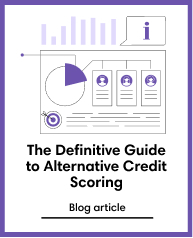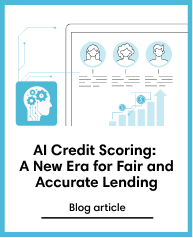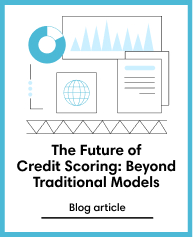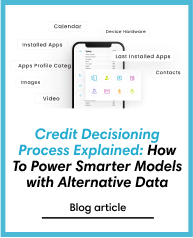Credit Scoring
Oct 6, 2022
How a new school of scoring makes credit more inclusive
Learn how new scoring methods incorporating alternative data can make credit more accessible for all
Subscribe to our newsletter
Scores were first introduced to most of us in school through test scores and grades. These scores showed our performances at school. Later in life, SAT and GMAT scores contributed even further by helping universities and potential employers assess our future performance and potential.
The credit scores of traditional credit bureaus are more like these predictive tests regarding lending and borrowing. And therein lies the problem. Traditional credit scores based on credit bureau data assume the people or businesses being scored already have some kind of formal credit or credit history.
However, where does that leave those who do not fall into the above category? Think of millennials and Gen X borrowers too young to have a long credit history and first-time entrepreneurs seeking funds to bring their business dreams to life.
Those are not the only problems associated with traditional credit bureau scores. What if the applicant had at least one loan that they defaulted on or settled in the past or had to increase his credit card utilisation for one month? It is hardly fair for them to be punished for this each time they seek credit in the future.
How do credit bureaus assess applicants, and why should it change?
According to myfico, there are the five data points that traditional credit bureaus assess when weighing up a credit score*:
- Payment history (35%)
- Amounts owed (30%)
- Length of credit history (15%)
- Credit mix (10%)
- New credit (10%)
However, this approach does not work well for borrowers new to credit. Not all borrowers behave the same with all lenders, loan amounts or loans.
Yes, an applicant’s payment history can give lenders a sense of their capacity and ability to repay the loan. However, it is equally critical to determine how willing they are to repay.
What happens when traditional credit data is missing?
But what do lenders do when they can’t get reliable data on the five points above?
Some base their decisions on:
- Demographics. Some behaviour scores assess ‘creditworthiness by association’. Some consider this ‘profiling’ or ‘stereotyping’, and some regulators have investigated it for being discriminatory.
- Utility and telecom payments. Missing a utility payment can lead to the service being turned off. That’s different from a loan, which has been sanctioned and disbursed. There are doubts about the usefulness of looking at utility payments for scoring.
- Cash flow and income. Banks and lenders looked to income and cash flow data to guide their credit decisions long before open banking. However, these methods are imperfect as they don’t help lenders understand a business or person’s risk of default.
Using these scoring approaches alone could continue pushing financial exclusion. And that creates a situation no one wants.
How to help people get access to credit?
There is another way: Smartphone and web behavioural metadata.
Lenders can get a fuller picture by seeking applicants’ consent to explore their digital footprint and online behaviour while applying for a financial product.
Research by the Federal Deposit Insurance Corporation and the Centre for Financial Research put digital footprint and credit bureau data neck and neck for predictiveness and accuracy. Supervised Machine Learning, according to IBM, is defined by its use of labelled datasets to train algorithms to classify data or accurately predict outcomes. For example, it has yielded accurate, reliable and stable data on the probability of defaults.
Here's what you should take away from this. First, alternative credit scoring does not replace traditional credit scoring. Second, alternative data sources like smartphone behavioural metadata do not replace traditional credit bureau data. Third, the more thoroughly we can assess creditworthiness, the better credit distribution will be. Finally, it is possible to be profitable and inclusive simultaneously.
Therefore, just as educators shouldn’t use one test to assess students’ futures, we should not rely on one way to score people seeking credit.
Interested in learning how our products can help you? Request a free demo, or drop us your questions here.
Access data insights solutions that deliver growth - Fraud detection | Credit scoring | Marketing segmentation. Helps you say "YES" more confidently to more customers!
Learn more about credolab's products and possibilities with our features through our Blog section, and feel free to share our content with your team!
Follow us on social or get in touch today: Book a meeting | Blog | LinkedIn | Twitter | Contact Us





